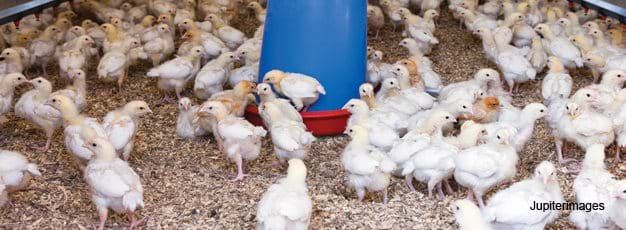Broiler Producers Search for Alternatives to Antibiotics

Listen to an interview with an author.
Antibiotics are widely used in modern livestock and poultry production to treat sick animals, but they are also administered in subtherapeutic doses to protect animals against disease and to promote growth. While the routine use of subtherapeutic antibiotics (STAs) can increase productivity, health officials, physicians, and veterinarians are concerned that extensive use is reducing the efficacy of antibiotics in treating human and animal diseases.
Widespread use of human and animal antibiotics can encourage the growth of drug-resistant pathogens. In agriculture, increased resistance to animal antibiotics can lead to more severe outbreaks of livestock disease. Resistant bacteria may cause disease directly, or they may pass genetic material associated with resistance on to other bacteria. In such cases, the widespread use of antibiotics, including STAs in animals, could help promote the development of drug-resistant bacteria that could pass from animals to humans, thus posing a danger to human health. In response to rising concerns, the European Union has banned STAs, and several major U.S. retailers and processors have moved to limit their use by input suppliers.
Recent ERS research summarizing the use of STAs in broiler chicken production draws on data from a large-scale survey of broiler producers (USDA’s 2006 Agricultural Resource Management Survey). Based on responses from over 1,500 producers of broilers for meat, STA use was not ubiquitous—42 percent of producers, representing 44 percent of production, did not use STAs in production in 2006 (this decision is actually made by the integrator that contracts with the farm).
Producers that did not use STAs relied instead on a portfolio of other practices to prevent disease and promote growth in broilers. About 75 percent of these producers had formal Hazard Analysis and Critical Control Point (HACCP) plans, a systematic approach to identify and prevent food safety hazards. In comparison, only 43 percent of the farms that used STAs had an HACCP plan in place. Producers that did not use STAs relied on different feeding routines than STA users, and their facilities were characterized by more rigorous sanitation practices, improved ventilation for poultry housing, and more extensive testing for pathogens.
These practices can limit the growth of pathogens and detect their spread early while limiting their resistance to antibiotics. Because these practices have been widely adopted on farms in many locations and sizes, they appear to be commercially viable, providing many of the benefits of STA use but without the risks.
The Transformation of U.S. Livestock Agriculture: Scale, Efficiency, and Risks, by James M. MacDonald and William D. McBride, USDA, Economic Research Service, January 2009
Sub-therapeutic Antibiotics and Productivity in U.S. Hog Production, Review of Agricultural Economics, June 2008, Vol. 30, No. 2, pp. 270-288


